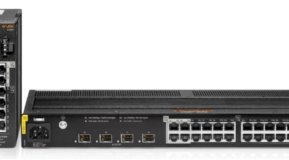
Since its inception in 2017, the Aruba CX portfolio of network switches was designed to empower IT with a modern network operator experience that simplifies the complexity of designing, deploying, and servicing enterprise networks.
Now, more than half a decade later, we’ve continued to build upon that legacy by delivering lasting value to new and existing customers through the regular implementation of innovative features and technologies in our Aruba AOS-CX switch software.
As we enter its 11th major release, let’s look at just a few of the latest anticipated and upcoming enhancements we’re bringing to customers through AOS-CX.
- Enhanced analytics and visibility with IPFIX and traffic insight, enabling client flow information collection and reporting to support traditional network operator tasks like capacity planning and security analysis.
- Extended flexibility and scale with Multiprotocol Label Switching (MPLS) available on Aruba CX 6400 v2 extended table line card modules to support connection-oriented label switching for various network protocols, including ECMP, PE-CE routing, and L3 VPN.
- Improved network uptime with VSF Enhanced Software Upgrade (ESU) for Aruba CX 6300 switches. This removes the need to reboot a full VSF stack during a software upgrade. It uses existing redundant management and hot-patching functionality keep members running and only requires the conductor to reboot at the end of the upgrade cycle.
- Expanded tunnelling and segmentation with multi-fabric VXLAN group-based policy support, relaying tags through virtual tunnel end points to enable role-based policy controls across VLANs in a variety of segmentation architectures and deployments.
This lays the groundwork for future VXLAN enhancements, like support for IPv6 VXLAN tunnel sources and expanded platforms for VXLAN GBP. By using IPv6 VXLAN tunnel source and EVPN-VXLAN, customers will have the flexibility to deploy native IPv6 without IPv4 configured in Multicast VXLAN, native IPv6 without IPv4 configured in overlay multicast, and IPv6 underlays alongside dual stack IPv4/IPv6 overlays in new IPv6 environments while existing IPv4 environments can continue to utilize IPv4 VXLAN tunnel source and dual stack overlays.
To learn more about the latest and previous iterations of AOS-CX, find the release notes available through the Aruba Support Portal, and access the Aruba AOS-CX Software Release Technical Update series on the Airheads Broadcasting channel.




